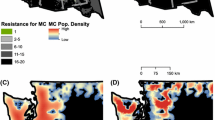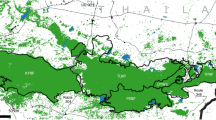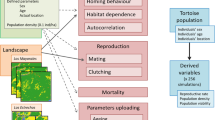Abstract
Landscape fragmentation affects wildlife population viability, in part, through the effects it has on individual dispersal. In addition, some forms of human disturbance impinge on dispersal without physically fragmenting habitats. Here, we use the term “landscape resistance” to capture constraints to dispersal that cannot be linked directly to fragmentation. The extent to which landscape resistance can influence population persistence is not well understood. Agricultural development over the past 60 years has resulted in considerable habitat fragmentation in the Riding Mountain National Park (RMNP) region in southwestern Manitoba, Canada. We examined how park boundaries, roads outside park boundaries and negative human attitudes have altered dispersal success and population persistence. We examined whether stochastic disturbance, representing infectious disease epidemics, further reduced long-term population persistence for various scenarios. Finally, we assessed whether the simultaneous occurrence of the three features had additive effects. We simulated dispersal using HexSim, a spatially explicit individual-based population model, parameterised with data on wolves (Canis lupus) in the RMNP region. Simulations that separately accounted for negative human attitudes and roads outside the park boundaries exhibited lower mean population size than those that ignored these details. Increasing deflection from park boundaries did not appear to have significant impacts. Our results did not indicate the presence of additive effects, and scenarios incorporating all three features had similar results as that of roads. Stochastic disturbance further reduced mean population size. Our results do illustrate how less-visible human disturbances (i.e. those that do not clearly alter landscape characteristics) can significantly limit dispersal and population persistence.


Similar content being viewed by others
References
Barker, I. K., & Parrish, C. R. (2001). Parvovirus infections. In E. S. Williams & I. K. Barker (Eds.), Infectious diseases of wild mammals (3rd ed., pp. 131–146). Ames: Iowa State University Press.
Benn, B., & Herrero, S. (2002). Grizzly bear mortality and human access in Banff and Yoho national parks, 1971–1998. Ursus, 13, 213–221.
Brook, R. K. (2008). Elk-agriculture conflicts in the Greater Riding Mountain Ecosystem: Building bridges between the natural and social sciences. Dissertation, University of Manitoba, Winnipeg, MB, Canada.
Brook, R. K. (2010). Habitat selection by parturient elk in agricultural and forested landscapes. Canadian Journal of Zoology, 88, 968–976.
Callaghan, C. J. (2002). The ecology of gray wolf (Canis lupus) habitat use, survival, and persistence in the Central Rocky Mountains, Canada. Dissertation, University of Guelph, Guelph, ON, Canada.
Canadian Parks and Wilderness Society (CPAWS). (2004). Riding Mountain ecosystem community atlas. http://cpaws.org/publications/atlas/index.php. Accessed August 2007.
Carbyn, L. N. (1980). Ecology and management of wolves in Riding Mountain National Park, Manitoba. Final Report, Large Mammal System Studies, Report No. 10, September 1975–March 1979. Edmonton, AB: Canadian Wildlife Service.
Carbyn, L. N. (1982). Incidence of disease and its potential role in the population dynamics of wolves in Riding Mountain National Park, Manitoba. In F. H. Harrington & P. C. Paquet (Eds.), Wolves of the world: Perspectives of behaviour, ecology and conservation (pp. 106–115). Park Ridge: Noyes.
Carroll, C. (2003). Impacts of landscape change on wolf viability in the northeastern U.S. and southeastern Canada: Implications for wolf recovery. Wildlands Project Special Paper No. 5. Richmond, VT: Wildlands Project.
Carroll, C., Phillips, M. K., Lopez-Gonzales, C. A., & Schumaker, N. H. (2006). Defining recovery goals and strategies for endangered species: the wolf as a case study. BioScience, 56, 25–37.
De Castro, F., & Bolker, B. (2005). Mechanisms of disease-induced extinction. Ecology Letters, 8, 117–126.
Environment Canada (1993). Canada: terrestrial ecoregions. http://atlas.nrcan.gc.ca/site/english/maps/archives/5thedition/environment/ecology/mcr4164#download. Accessed May 2007.
Ernest, H. B., Boyce, W. M., Bleich, V. C., May, B., Stiver, S. J., & Torres, S. G. (2003). Genetic structure of mountain lion (Puma concolor) populations in California. Conservation Genetics, 4, 353–366.
Franklin, J. F. (1993). Preserving biodiversity: species, ecosystems, or landscapes? Ecological Applications, 3, 202–205.
Fritts, S. H. (1983). Record dispersal by a wolf from Minnesota. Journal of Mammalogy, 64, 166–167.
Fritts, S. H., & Mech, L. D. (1981). Dynamics, movements, and feeding ecology of a newly protected wolf population in northwestern Minnesota. Wildlife Monographs, 80. Bethesda: The Wildlife Society.
Fritts, S. H., & Carbyn, L. N. (1995). Population viability, nature reserves, and the outlook for gray wolf conservation in North America. Restoration Ecology, 3, 26–38.
Fuller, T. K. (1989). Population dynamics of wolves in north-central Minnesota. Wildlife Monographs, 105. Bethesda: The Wildlife Society.
Fuller, T. K., & Murray, D. L. (1998). Biological and logistical explanations of variation in wolf population density. Animal Conservation, 1, 153–157.
Fuller, T. K., Mech, L. D., & Cochrane, J. F. (2003). Wolf population dynamics. In L. D. Mech & L. Boitani (Eds.), Wolves: Behaviour, ecology and conservation (pp. 161–191). Chicago: University of Chicago Press.
Geffen, E., Anderson, M. J., & Wayne, R. K. (2004). Climate and habitat barriers to dispersal in the highly mobile grey wolf. Molecular Ecology, 13, 2481–2490.
Gerber, L. R., McCallum, H., Lafferty, K. D., Sabo, J. L., & Dobson, A. P. (2005). Exposing extinction risk analysis to pathogens: Is disease just another form of density dependence? Ecological Applications, 15, 1402–1414.
Gese, E. M., & Mech, L. D. (1991). Dispersal of wolves (Canis lupus) in northestern Minnesota, 1969–1989. Canadian Journal of Zoology, 69, 2946–2955.
Gooding, R., & Brook, R. K. (2011). Spatial and temporal trends in crop damage by white-tailed deer and elk in Manitoba: Implications for bovine tuberculosis management. Final report to Parks Canada.
Goulet, G. D. (1993). Comparison of temporal and geographical skull variation among Nearctic modern, Holocene and Late Pleistocene gray wolves (Canis lupus) (and selected Canis). Thesis, University of Manitoba, Winnipeg, MB, Canada.
Haight, R. G., Mladenoff, D. L., & Wydeven, A. P. (1998). Modeling disjunct gray wolf populations in semi-wild landscapes. Conservation Biology, 12, 879–888.
Johnson, M. R., Boyd, D. K., & Pletscher, D. H. (1994). Serologic investigations of Canine Parvovirus and Canine Distemper in relation to wolf (Canis lupus) pup mortalities. Journal of Wildlife Diseases, 3, 270–273.
Keith, L. B. (1983). Population dynamics of wolves. In Carbyn, L. N. (Ed.), Wolves in Canada and Alaska: Their status, biology, and management (pp. 66–77). Report Series 45. Ottawa: Canadian Wildlife Service.
Koenig, W. D., Van Vuren, D., & Hooge, P. N. (1996). Detectability, philopatry, and the distribution of dispersal distances in vertebrates. Trends in Ecology and Evolution, 11, 514–517.
Kramer-Schadt, S., Revilla, E., Wiegand, T., & Breitenmoser, U. (2004). Fragmented landscapes, road mortality and patch connectivity: Modelling influences on the dispersal of Eurasian lynx. Journal of Applied Ecology, 41, 711–723.
Lehman, N., Eisenhawer, A., Hansen, K., Mech, L. D., Peterson, R. O., Gogan, P. J. P., et al. (1991). Introgression of coyote mitochondrial DNA into sympatric North American gray wolf populations. Evolution, 45, 104–119.
Manitoba Conservation (2004). Duck Mountain Provincial Park. http://www.gov.mb.ca/conservation/parks/popular_parks/duck_mtn/info.html. Accessed June 2007.
McNamee, K. (1993). From wild places to endangered spaces: A history of Canada’s national parks. In P. Dearden & R. Rollins (Eds.), Parks and protected areas in Canada: Planning and management (pp. 17–44). Toronto: Oxford University Press.
Mech, L. D. (1987). Age, season, distance, direction and social aspects of wolf dispersal from a Minnesota pack. In D. B. Chepko-Sade & Z. T. Halpin (Eds.), Mammalian dispersal patterns: The effects of social structure on population genetics (pp. 55–74). Chicago: University of Chicago Press.
Mech, L. D., Goyal, S. M., Paul, W. J., & Newton, W. E. (2008). Demographic effects of canine parvovirus on a free-ranging wolf population over 30 years. Journal of Wildlife Diseases, 44, 824–836.
Mladenoff, D. J., Sickley, T. A., Haight, R. G., & Wydeven, A. P. (1995). A regional landscape analysis and prediction of favorable gray wolf habitat in the northern Great Lakes region. Conservation Biology, 9, 279–294.
Musiani, M., Muhly, T., Callaghan, C., Gates, C. C., Smith, M. E., Stone, S., et al. (2004). Wolves in rural agricultural areas of Western North America: Conflict and conservation. In N. Fascione, A. Delach, & M. E. Smith (Eds.), People and predators: From conflict to coexistence (pp. 51–80). Washington: Island Press.
Noss, R. (1995). Maintaining ecological integrity in representative networks. World Wildlife Fund Canada and World Wildlife Fund US.
Paquet, P. C. (1992). Prey use strategies of sympatric wolves and coyotes in Riding Mountain National Park, Manitoba. Journal of Mammalogy, 72, 337–343.
Peterson, R. O. (1995). The wolves of Isle Royale: A broken balance. Minocqua: Willow Creek Press.
Parks Canada. (2004). Riding Mountain National Park: Ecological Integrity Statement. http://www2.parkscanada.gc.ca/pn-np/mb/riding/plan/plan3_e.asp. Accessed June 2007.
Parks Canada (2006). Riding Mountain National Park: Natural heritage. http://www2.parkscanada.gc.ca/pn-np/mb/riding/natcul/natcul1_E.asp. Accessed June 2007.
Ponech, C. (1997). Attitudes of area residents and various interest groups towards the Riding Mountain National Park wolf population. Thesis, University of Manitoba, Winnipeg, MB, Canada.
Riley, S. P. D., Pollinger, J. P., Sauvajot, R. M., York, E. C., Bromley, C., Fuller, T. K., et al. (2006). A southern California freeway is a physical and social barrier to gene flow in carnivores. Molecular Ecology, 15, 1733–1741.
Sallows, T. A. (2007). Diet preferences and parasites of grey wolves in Riding Mountain National Park of Canada. Thesis, University of Manitoba, Winnipeg, MB, Canada.
Schumaker, N. H. (1998). A user’s guide to the PATCH model. EPA/600/R-98/135. Corvallis: US Environmental Protection Agency, Environmental Research Laboratory.
Smith, D., Meier, T., Geffen, E., Mech, L. D., Burch, J. W., Adams, L. G., et al. (1997). Is incest common in gray wolf packs? Behavioral Ecology, 8, 384–391.
Soulé, M. E., & Simberloff, D. (1986). What do genetics and ecology tell us about the design of nature reserves. Biological Conservation, 35, 19–40.
South, A. B., Rushton, S. P., Kenward, R. E., & Macdonald, D. W. (2002). Modelling vertebrate dispersal and demography in real landscapes: How does uncertainty regarding dispersal behaviour influence predictions of spatial population dynamics? In J. M. Bullock, R. E. Kenward, & R. S. Hails (Eds.), Dispersal ecology (pp. 327–349). Oxford: Blackwell.
Stronen, A. V. (2009). Dispersal in a Plain Landscape: Wolves in Southwestern Manitoba, Canada. Dissertation, University of New Brunswick, Fredericton, NB, Canada.
Stronen, A. V., Brook, R. K., Paquet, P. C., & McLachlan, S. M. (2007). Farmer attitudes toward wolves: Implications for the role of predators in managing disease. Biological Conservation, 135, 1–10.
Stronen, A. V., Forbes, G. J., Sallows, T., Goulet, G., Musiani, M., & Paquet, P. C. (2010). Wolf body mass, skull morphology, and mitochondrial DNA haplotypes in the Riding Mountain National Park region of Manitoba, Canada. Canadian Journal of Zoology, 88, 496–507.
Stronen, A. V., Forbes, G. J., Paquet, P. C., Goulet, G., Sallows, T., & Musiani, M. (2011) Dispersal in a plain landscape: Short-distance genetic differentiation in southwestern Manitoba wolves, Canada. Conservation Genetics doi:10.1007/s10592-011-0290-1. Published online 26 November 2011.
Van Vuren, D. (1998). Mammalian dispersal and reserve design. In T. Caro (Ed.), Behavioral ecology and conservation biology (pp. 369–393). Oxford: Oxford University Press.
vonholdt, B. M., Stahler, D. R., Smith, D. W., Earl, D. A., Pollinger, J. P., & Wayne, R. K. (2008). The geneaology and genetic viability of reintroduced Yellowstone grey wolves. Molecular Ecology, 7, 252–274.
Walker, D. J. (2001). Landscape complexity and vegetation dynamics in Riding Mountain National Park, Canada. Dissertation, University of Manitoba, Winnipeg, MB, Canada.
Waser, P. M. (1985). Does competition drive dispersal? Ecology, 66, 1170–1175.
Weaver, J. L., Paquet, P. C., & Ruggiero, L. F. (1996). Resilience and conservation of large carnivores in the Rocky Mountains. Conservation Biology, 10, 964–976.
Whittington, J., St, C., Clair, C., & Mercer, G. (2005). Spatial responses of wolves to roads and trails in mountain valleys. Ecological Applications, 15, 543–553.
Wiens, J. A. (1997). Metapopulation dynamics and landcape ecology. In I. Hanski & M. Gilpin (Eds.), Metapopulation biology: Ecology, genetics and evolution (pp. 43–62). London: Academic.
Wydeven, A.P., Schultz, R.N., & Thiel, R.P. (1995). Monitoring of a recovering gray wolf population in Wisconsin, 1979–1991. In L.N. Carbyn, S.H. Fritts, D.R. Seip (Eds.), Ecology and Conservation of Wolves in a Changing World (pp. 147–156). Occasional Publication No. 35. Edmonton: Canadian Circumpolar Institute.
Acknowledgements
We thank M. Desrochers and S. Frey for their assistance with GIS analyses, and D. Keppie and S. Woodley for helpful comments on earlier versions of the manuscript. Parks Canada, the Sustainable Development Innovations Fund at Manitoba Conservation, World Wildlife Fund Canada, Manitoba Agriculture and Rural Initiatives and Louisiana Pacific Canada provided funding for the study. Parks Canada assisted in kind with collection of data. The information in this document has been funded in part by the US Environmental Protection Agency. It has been subjected to review by the National Health and Environmental Effects Research Laboratory’s Western Ecology Division and approved for publication. Approval does not signify that the contents reflect the views of the Agency, nor does mention of trade names or commercial products constitute endorsement or recommendation for use.
Author information
Authors and Affiliations
Corresponding author
Rights and permissions
About this article
Cite this article
Stronen, A.V., Schumaker, N.H., Forbes, G.J. et al. Landscape resistance to dispersal: simulating long-term effects of human disturbance on a small and isolated wolf population in southwestern Manitoba, Canada. Environ Monit Assess 184, 6923–6934 (2012). https://doi.org/10.1007/s10661-011-2469-9
Received:
Accepted:
Published:
Issue Date:
DOI: https://doi.org/10.1007/s10661-011-2469-9




